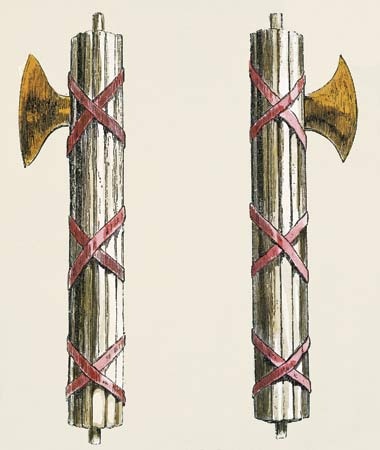fasces
symbol
 (plural form of Latin fascis: “bundle”) in ancient Rome, insignia of official authority. It was carried by the lictors, or attendants, and was characterized by an ax head projecting from a bundle of elm or birch rods about 5 feet (1.5 metres) long and tied together with a red strap; it symbolized penal power. When carried inside Rome, the ax was removed (unless the magistrate was a dictator or general celebrating a triumph) as recognition of the right of a Roman citizen to appeal a magistrate's ruling. The discovery of a miniature iron set of fasces in a 7th-century BC Etruscan tomb at Vetulonia confirms the traditional view that Rome derived the fasces from the Etruscans. The Roman emperors, beginning with Augustus in 19 BC, had 12 fasces, but, after Domitian (reigned AD 81–96), they had 24; dictators, 24; consuls, 12; praetors, 6; legates, 5; priests, 1. Lowering of the fasces was a form of salute to a higher official.
(plural form of Latin fascis: “bundle”) in ancient Rome, insignia of official authority. It was carried by the lictors, or attendants, and was characterized by an ax head projecting from a bundle of elm or birch rods about 5 feet (1.5 metres) long and tied together with a red strap; it symbolized penal power. When carried inside Rome, the ax was removed (unless the magistrate was a dictator or general celebrating a triumph) as recognition of the right of a Roman citizen to appeal a magistrate's ruling. The discovery of a miniature iron set of fasces in a 7th-century BC Etruscan tomb at Vetulonia confirms the traditional view that Rome derived the fasces from the Etruscans. The Roman emperors, beginning with Augustus in 19 BC, had 12 fasces, but, after Domitian (reigned AD 81–96), they had 24; dictators, 24; consuls, 12; praetors, 6; legates, 5; priests, 1. Lowering of the fasces was a form of salute to a higher official.Benito Mussolini's Fascist Party of Italy was named for the fasces, which the members adopted in 1919 as their emblem. The Winged Liberty dime, minted in the United States from 1916 to 1945, depicts the fasces on its obverse side.
- Teófilo Stevenson
- Teṉkalai
- T F Middleton
- Thaba Bosiu
- Thabana Ntlenyana
- Thabazimbi
- Thabo Mbeki
- Thackeray, William Makepeace
- Thaddeus Stevens
- Thai Binh
- Thailand
- Thailand, flag of
- Thailand, Gulf of
- Thai language
- Thai literature
- Thai Nguyen
- Thais
- Thakin Than Tun
- Thaksin Shinawatra
- Thal
- thalamus
- thalassemia
- Thalassery
- Thalberg, Irving
- Thalberg, Sigismond